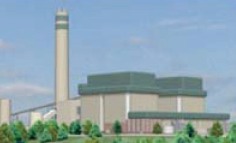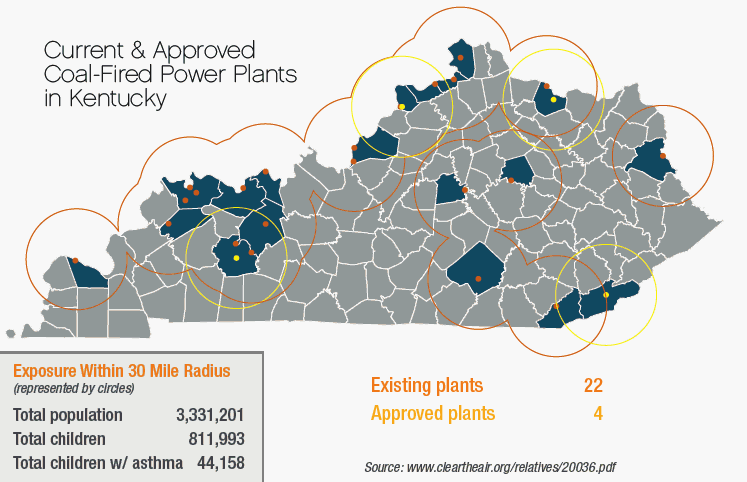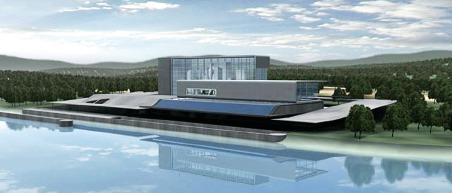- 401 Frederica Street, B-203
- Owensboro, Kentucky 42301
- (270) 685-2652 | FAX (270) 685-6074
Coal-fired Power Plants
An economic opportunity or a threat to the health and livability of our region?
by Rodney Berry
Kathy Strobel, Research Assistant
More plants coming
The resurgence of interest in coal-fired plants has been sparked by demand for energy, an increased desire to wean our nation away from foreign oil, relaxed environmental regulation and government subsidies. Generally, proposals for such plants are driven by speculation, boom and bust cycles, and swings in market reactions to events such as the California power crisis and the Enron scandal.
|
In the past few years, more than a hundred coal-fired power plants have been proposed nationwide. More than 20 of those were planned for Kentucky. Currently, five power plant proposals have received final permits for construction:
- Kentucky Mountain Power (Harlan County)
- Bluegrass Energy (Oldham County – gas-fired)
- Peabody Thoroughbred (Muhlenberg County)
- East Kentucky Power Spurlock – Units 3 & 4 (Mason County)
- Louisville Gas and Electric – Unit 2 (Trimble County)
Other plants are in various stages of approval and some proposals may resurface. When that occurs, Kentucky sites will certainly be among the most appealing to investors.
Our air and water quality is also affected by coal-fired power plants in Indiana, Illinois, Missouri and other areas west of our state. More than a dozen sites have been considered for coal-fired power plants in these areas as well.
Among the projects closer to home that warrant close public scrutiny:
Peabody Thoroughbred Plant
 A $2.1 billion 1500 megawatt plant proposed for Muhlenberg County, the plant has been presented as a test case for a new generation of large coal-fired plants. It would be fueled by six million tons of coal per year from Peabody’s new adjacent underground mine. The plant would create 450 permanent jobs and make a $100 million annual economic impact.
A $2.1 billion 1500 megawatt plant proposed for Muhlenberg County, the plant has been presented as a test case for a new generation of large coal-fired plants. It would be fueled by six million tons of coal per year from Peabody’s new adjacent underground mine. The plant would create 450 permanent jobs and make a $100 million annual economic impact.
LaJuana Wilcher, Kentucky’s Environmental and Public Protection secretary, recently rejected a hearing officer’s ruling that would have required Peabody to make extensive changes in its air quality permit proposal. Environmental groups filed suit in May 2006 to overturn the secretary’s action.
The lawsuit claims that the Peabody plant:
- would not be required to use the best available technology
- would sell the power on the open market since Kentucky already has enough generating capacity
- would decrease air quality downwind from the plant in counties that already do not meet ground level EPA ozone levels
- would account for 12 percent of the state’s mercury emissions
- would impair visibility at Mammoth Cave National Park
Muhlenberg County officials point to the need for high wage jobs in an area of high unemployment and the overall economic impact of the investment.
Peabody officials say the plant:
- would be among the cleanest coal-fired generating plants ever built
- would emit one-fifth of the pollutants of average coal-fired power plants
- cannot justify the use of certain new technologies
- would stabilize the mining industry by providing critical power sources for distributors who otherwise would purchase electricity out of state
FutureGen Power Plant
An artist’s conception of the facility proposed for a Henderson County site across the Daviess County line on the Green River near Curdsville. |
This plant would be a $1 billion public-private project ($250 million private, $700 million public). Intended to be the world’s first coal-fueled plant with zero carbon dioxide emissions, it would test the feasibility of producing electricity and hydrogen from coal while capturing and permanently storing carbon dioxide in a geological formation 7,400 feet below the ground. Nine states are competing for the plant.
- Several sites will be eliminated in July 2006
- The site will be selected in the fall 2007 and the plant operational by 2012
- Site advantages: proximity to coal reserves/production, geological features, confluence of Green and Ohio rivers
- Plant would sell its power rather than be used in neighboring areas
- Would produce electricity for 150,000 homes
- Hydrogen would be used in fuel cells
- In a June 2006 special session, Kentucky legislators approved up to $90 million in tax incentives. Kentucky has also offered to team with Ohio and Pennsylvania to supply the coal and offer research support.
- The project would create 1,300 to 1,500 construction jobs and 150 permanent jobs.


